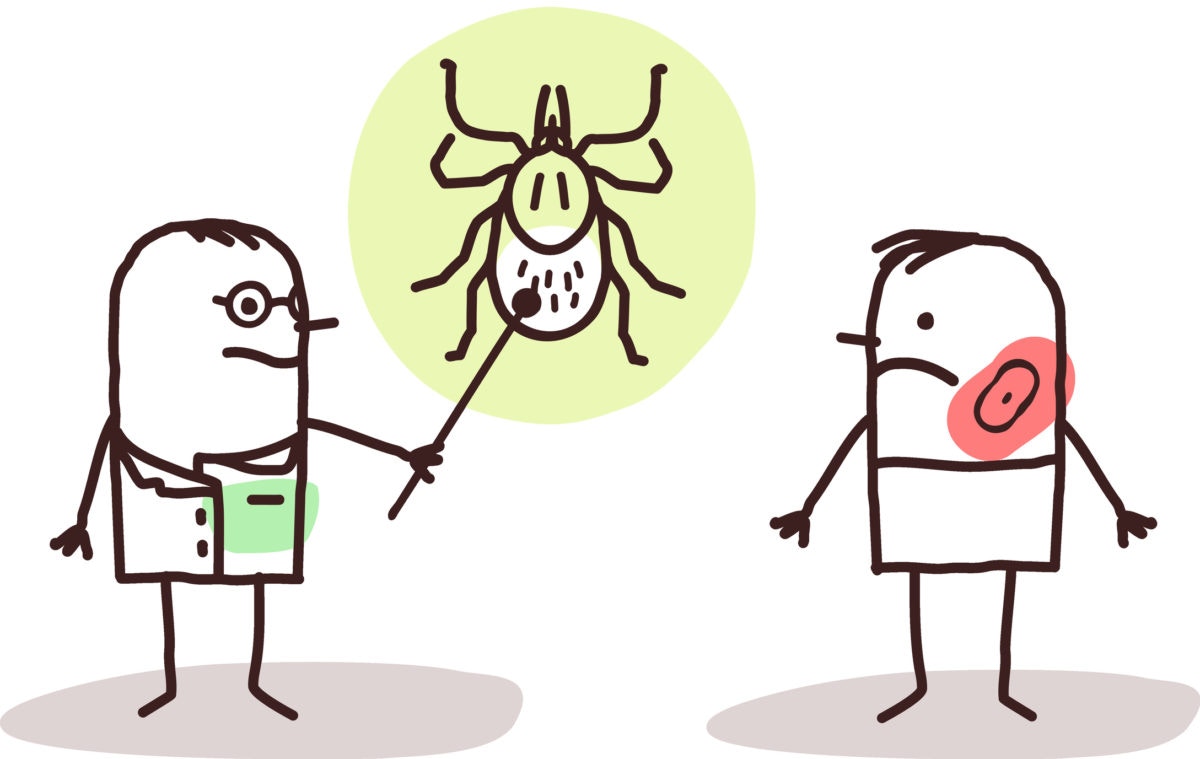Last spring, my four-year-old began to complain that his ear was hurting. This alone didn’t raise any red flags for us since between two kids, someone is basically always complaining about something, be it ears, knees, itches, or bumps. He wasn’t feverish and when I tugged on his earlobe it didn’t hurt, so I more or less chalked it up to a little lingering swimmer’s ear or maybe a touch of attention-seeking as he’s prone to do from time to time. He didn’t seem too bothered either and didn’t mention it again for the rest of the week. The next week, though, on a few separate occasions, he mentioned that his ear, once again, was hurting. This time, he added, it hurt “on the outside.” I took a look and couldn’t see anything, and again he wasn’t running a fever or sick in any other way, so we just went about our business as usual. Finally though, while rinsing his hair in the tub one night, I brushed the top edge of his ear with my hand and he winced. Curious, I folded the top of his ear back and tried to peer into the tiny crease. Sure enough, a purple lump was buried deep, deep inside, with two hair-thin legs sticking out of it. It took both of us to hold him still while my husband removed the tick with tweezers. We are New Englanders, and this isn’t our first tick, so we knew the drill. We cleaned the area and applied antibiotic ointment throughout the week that followed. I monitored it for signs of infection or the telltale red ring that forms around Lyme-infected tick bites. We’d been through this before; I told myself we didn’t need to worry. But a week later, he got sick. He spiked a fever to 104 with no other visible symptoms. He complained his knees hurt. He was miserable, and I felt horrible. Had I missed it? Did he have Lyme disease? What now? Lyme disease is a bacterial infection primarily transmitted by Ixodes ticks, also known as deer or black-legged ticks. While many people believe that Lyme disease is only found on the east coast of the U.S., it is actually found throughout many other areas of the United States, as well as in more than sixty other countries. The CDC estimates that approximately 300,000 people are diagnosed with Lyme disease in the U.S. each year, but because the diagnosis is so difficult, some experts believe that the actual number of people afflicted may be much higher. I hurried my son off to the doctor. Too young for the conventional Lyme treatment, he took a three-week course of amoxicillin and was as good as new. But as we talked with friends and family, we realized that the questions we’d had were common among almost all of the caregivers we knew. How do you prevent ticks? What do you do when you find one? When should you call the doctor or treat for Lyme? Luckily, I knew just who to ask. Dr. Elizabeth McKeen is an Instructor of Pediatrics at Harvard Medical School and is a practicing pediatrician at Pediatric Health Care Associates in Peabody, Massachusetts. She sat down to answer all the questions I had about treating and preventing Lyme Disease in children. Here is what she had to say:
What should a parent do when they find a tick on their child?
First things first: do not try to burn or freeze the tick off. The American Academy of Pediatrics (AAP) recommends first trying the soapy cotton ball technique. Soak a cotton ball in liquid soap and then apply this to the tick. Hold for 30 seconds and then remove. Often the tick will adhere to the cotton ball and will come off. If this doesn't work, use tweezers to gently grab the tick and pull straight upwards. Try to avoid twisting or crushing the tick. If the tick is truly a tiny deer tick (Ixodes scapulars), sometimes you will need to actually just scrape the tick off with the edge of the tweezers. When done, apply a small amount of antibiotic 2-3 times per day until the area is healed.When should I call the doctor about a tick?
Call your doctor anytime you are worried or have questions – especially since when it comes to tick-borne illnesses, googling can be misleading. You should definitely call if your child has expanding redness around the area of the bite, or if your child develops a fever. We see children in the office any time a caregiver is worried about the appearance of the area of the bite, if the family needs assistance removing the tick, or if the child has a fever or other systemic symptoms. If you feel uncomfortable removing the tick or if you're afraid that part of the tick has been left behind, most physicians will remove it in the office for you.What symptoms should I watch for after a tick bite?
Most tick bites are harmless. It is important to know that even if the tick is of the Ixodes scapularis species and you live in an area where Lyme is prevalent if you remove the tick within 24 hours, the chance of transmission of Lyme disease is essentially zero. (Note that other possible diseases may be transmitted more quickly.) That said, here is the KEY point to be aware of: the rash that is the first presenting sign of early Lyme disease does not occur right after the tick bite. It tends to present one to three weeks after the tick bite occurs. Thus, I recommend that families monitor the site of the tick bite for 30 days, and call their physician if they see a round or oval red rash expanding from the center of the tick bite.Should I save the tick?
You can certainly save the tick and bring it to your doctor for help with identification by visualization. In years past, some labs would accept ticks for identification, but fewer and fewer are doing this, so your doctor may not send the tick out.When should a child be treated prophylactically for Lyme?
In adults, and children over 8 years old, the Infectious Diseases Society of America recommends prophylaxis with a single dose of doxycycline if ALL of the following circumstances are met:- if the tick was certainly an Ixodes Scapularis
- if the tick was likely in place for more than 36 hours
- if prophylaxis can be taken within 72 hours of the tick bite
- if the patient lives in an area where the rate of infection of I. Scapularis ticks with B. Burgdorferi is >20% (which it is in most of New England)
- if no contraindication to doxycycline exists.
Are there ever scenarios in which I should worry about Lyme even if I have not found a tick on my child?
Yes, absolutely. In a small number of cases of Lyme disease, there is no history of tick bite. Thus, even if you did not see a tick on your child if he or she develops an expanding, red, round or oval rash, and you live in a Lyme endemic area, contact your child's doctor for an evaluation. Luckily, not long after my son began his 3-week course of amoxicillin, he began to feel better and his fever resolved. We finished the course of the medication, but we will never know for certain whether his fever was caused by Lyme disease. One thing is certain, though. This spring, as the temperatures warm, we’ll be taking more care than usual to prevent tick bites. According to the CDC, ticks are most active from April to September, so tick season is just around the corner and this year is predicted to be a bad one, at least in New England.Here are some ways to look after yourself and your little ones by practicing these keys to tick bite prevention:
- Avoid direct contact with ticks. Try to avoid wooded and brushy areas with high grasses and leaf litter. When in areas such as these, try to keep to the center of the trail.
- Repel ticks with DEET or permethrin. While parents may worry about applying DEET to their children, the FDA has deemed DEET in concentrations less than 30% safe for children over 2 months of age. When applying insect repellents to children, avoid their hands, around the eyes, and cut or irritated skin. If you would rather not use DEET, consider wearing clothing that has been treated with permethrin. You may purchase pretreated clothing or treat your own clothes at home.
- Find and remove ticks from your body. Bathe or shower as soon as possible after coming indoors (preferably within 2 hours) to wash off and more easily find ticks that are crawling on you. Inspect your body for ticks, using a mirror if necessary. Areas where ticks are commonly found include: under the arms, in and around the ears, inside the belly button, behind the knees, between the legs, around the waist, and especially in the hair. Finally, tumble dry clothes in a dryer on high heat for 10 minutes to kill ticks on dry clothing after you come indoors.
- Do nightly tick checks on your child. If you live in an area where Lyme disease is a known risk, check your child for ticks nightly, even on days when you don’t believe he or she could have been exposed to them. Look in and around the folds of the ears, on the scalp/hair, and in the underwear area in particular. This will hopefully reveal any attached ticks in a timely manner and will reduce the risk of Lyme transmission significantly.



